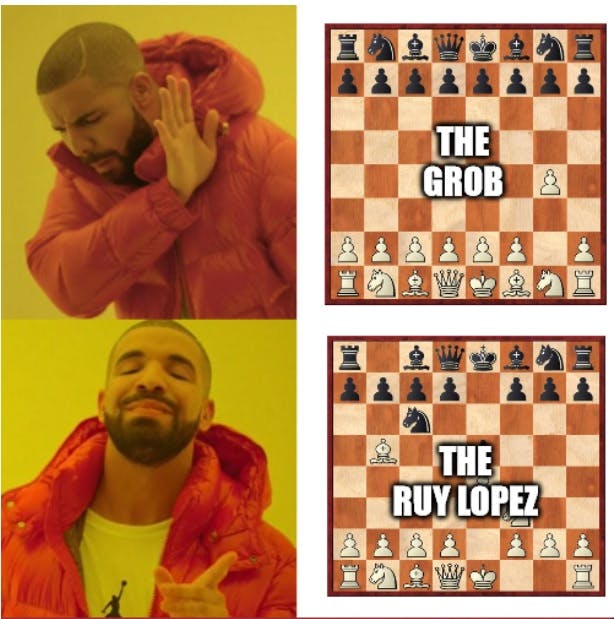Are you sure you want to delete your account?
(This will permanently delete all of your data - purchases, game scores, ratings, etc)
Change your username
Your current username is: guest
Change your account email address
Your current account email is:
Redeem your Fampay code here!
Use your Fampay code to get access to the Play Magnus Plus Membership!

Play Sound Openings
What do you think about get-rich schemes? You know: “Sign up here, spin the wheel, win a prize and become a millionaire…after you pay a small commission for processing the payment!” Obviously, most of such schemes are organized by fraudsters with the intent of milking money from gullible people. The same can be said of quite a few chess products that target casual players and promise great returns with minimal effort. The next time you hear about a “new great risky opening line that can be mastered in 15 minutes and that will help you catch your opponent off guard and win quickly”, ask yourself: What is the catch? If the opening is so incredible, why are not everyone and his grandmother playing it already? Do a quick search on the Internet and check whether the line is sound or not. If possible, ask an expert whom you trust. Find out whether strong Grandmasters employ this line nowadays. Use your chess engine or some online tool to see how the computer evaluates the starting position and the main lines of the variation.
Also, if you are still in doubt after the steps suggested above, make sure to check a few credible sources instead of relying on a single opinion. After all, there are plenty of ways to make terrible openings look smooth and shiny, including:
• Providing flawed or biased analysis. First of all, some authors, intentionally or not, fail to mention the most critical lines that pretty much refute their weapon of choice or at least take the sting out of it. Instead, they showcase lines where the opponent “cooperates” by taking all that’s on offer in the style of amateurs from the 19th century and goes on to suffer a humiliating and swift defeat. Unfortunately, when you try to replicate this scenario over the board, your opponents turn out to be less obliging and start making different moves as compared to the ones you have been served by the author, posing problems for you. Secondly, some of the authors offer faulty lines that have probably not been checked with a chess engine. For instance, according to the opening guru, White should be winning there, but a reality check with Stockfish reveals that Black has a witty resource that completely turns the tables! Thirdly, sometimes when the editor asks a highly-qualified and responsible author to create a course about a dubious opening, the latter’s conscience doesn’t allow him to advertise the lines too much, so he has to resort to such vague statements as “the position is unclear”, “with mutual chances”, “you get a playable position of your liking”, etc., in order to conceal the fact that you are outright worse at the end of the line.
• Hand-picking model games to make a favorable impression. A common trick is to neglect all the painful losses that the author and other fans of this variation have suffered in this line and demonstrate a few magnificent victories, especially if those were achieved against eminent players. This ploy creates an illusion that all you need to do to beat a tough opponent is to employ this fantastic opening. However, if you check out the author’s overall performance in this line, it turns out to be quite modest.
• Argument from authority. Another typical gimmick is to pick games by top players who at some point deliberately used inferior openings for trolling, due to being under the weather, for friendly fun, for giving odds to a lesser opponent, and so on. Basically, the author shows you a game played by a super Grandmaster and goes on to claim that if he can get away with employing such an opening, then you definitely can. The truth is, if Magnus Carlsen, who is known for such merry experiments, plays something atrocious such as the Grob (1.g4) in bullet to assert his dominance and tilt the opponent, it doesn’t make the opening good enough for a competitive club player who wants to improve in classical chess.
The problem with playing offbeat openings is that they are primarily based on exceptions from the rules, while an improving player needs to learn the rules and principles of chess. Indeed, there are masters who keep playing the same dubious systems all life long and even recommend doing so to others. However, the truth is that one of the reasons why they got stuck at master level is probably directly connected to the fact that they failed to familiarize themselves with other important types of positions and pawn structures. Instead, they had to resort to mending their semi-broken opening weapons year after year, wasting time and hindering their progress.
Why keep beating a dead horse and playing so-so lines when you can go for the main lines and study the games of the very top GMs, thus enriching your knowledge of the game? Moreover, you will be getting better positions this way. The “play mainline openings” approach is being advocated by the prevailing majority of the opening experts, from GM Gennady Timoschenko (“An Opening Repertoire of an Upcoming Master”) to the slogan of Quality Chess’s “Grandmaster Repertoire” series – “Tired of bad positions? Try the main lines!”
Of course, what I have been preaching above doesn’t mean that you should be as strict on yourself as not to employ any crazy lines at all under any circumstances. Just imagine that you are on a diet: an occasional ice cream from time to time is probably OK for most of us, but eating it every day in large quantities is not recommended for anyone.
P.S. Needless to be said, this blog post is written from the perspective of a person who views chess as a competitive activity and wishes to improve in it. I fully understand that some people take immense joy and pride in achieving an upset win now and then by using their trademark offbeat opening weapon, even if they have to suffer a long streak of losses to get there one day.
The Magnus Trainer app has a series of lessons specifically dedicated to the topic of creating a comprehensive opening repertoire for White and for Black based on sound openings. From adventurous gambits to solid, maneuvering lines, all the openings in the app were hand-picked to help you master only those lines that would serve you well for a lifetime regardless of your playing strength. After all, quite a few of the model games featured in the lessons come from Magnus Carlsen’s tournament games, up to the World Chess Championship level.

